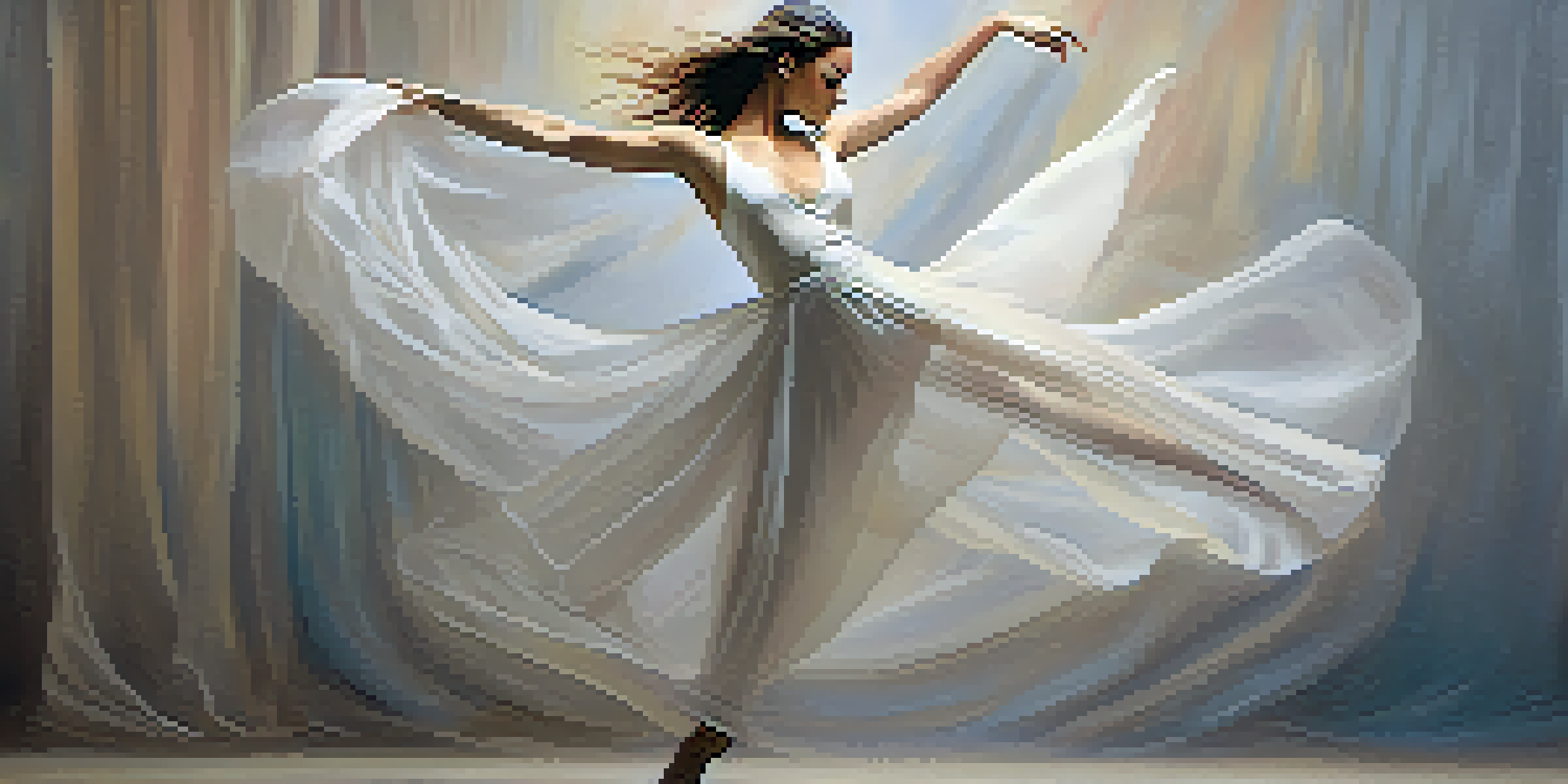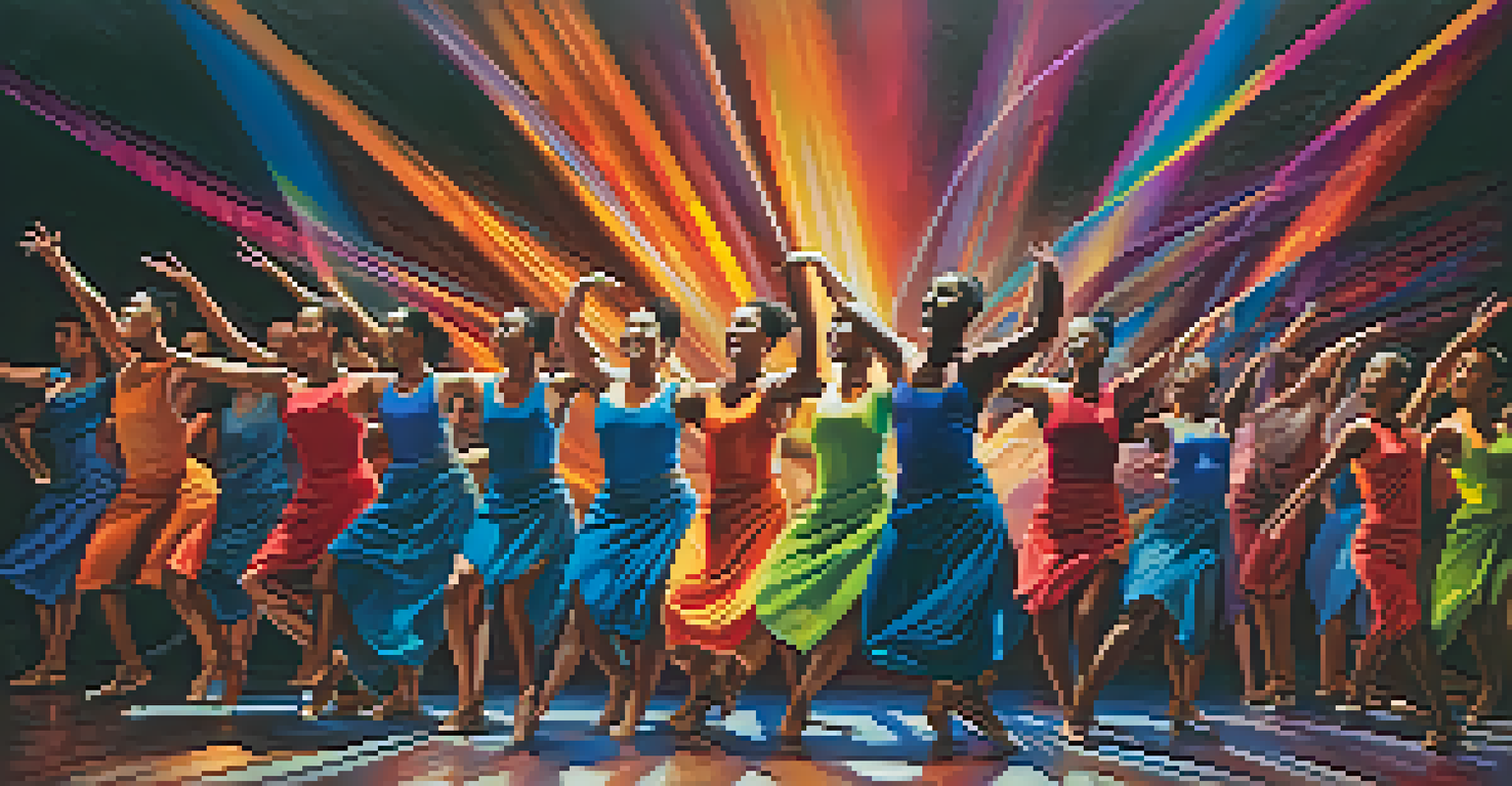The Impact of Poetry on Dance: A Collaborative Perspective

The Symbiotic Relationship Between Poetry and Dance
Poetry and dance share a unique bond, each enhancing the other in profound ways. Just as a poem captures emotions with words, dance conveys feelings through movement. This synergy allows artists to explore themes that resonate deeply with audiences, creating a holistic experience.
Dance is the hidden language of the soul.
For instance, a poignant poem might inspire a choreographer to express its sentiments through intricate dance movements. The rhythm of the poem can guide the pace of the dance, creating a seamless flow between verbal and physical expression. This interdependence enriches both art forms, resulting in a more immersive experience.
Ultimately, the collaboration between poetry and dance invites viewers to engage with art on multiple levels, fostering a deeper connection to both the word and the movement. It encourages artists to push boundaries, leading to innovative performances that challenge traditional norms.
Rhythm: The Heartbeat of Both Art Forms
At the core of poetry and dance lies rhythm, a fundamental element that drives both disciplines. In poetry, rhythm is established through meter and cadence, while in dance, it manifests through movement and timing. This shared pulse creates a synergy that enhances the emotional impact of a performance.

For example, a slow, deliberate poem can inspire a graceful, flowing dance that mirrors its contemplative nature. Conversely, an upbeat, lively poem might result in energetic movements that evoke joy and excitement. The interplay of rhythm between the two art forms sets the stage for powerful storytelling.
Poetry and Dance Enhance Each Other
The collaboration between poetry and dance creates a holistic artistic experience that resonates deeply with audiences.
By embracing rhythm, artists can create a captivating experience that resonates with audiences, transcending language barriers. This universal quality allows poetry and dance to communicate emotions that words alone may fail to convey.
Storytelling: Weaving Narratives Through Movement
Both poetry and dance excel at storytelling, whether through vivid imagery or expressive movement. Poems often tell stories that evoke strong emotions, while dance can bring these narratives to life in a visual format. This collaboration creates a multi-dimensional experience for the audience.
Poetry is the rhythmical creation of beauty in words.
Consider a narrative poem about love lost; a dancer might interpret this theme through movements that express longing and heartache. The combination of spoken word and dance can transport viewers into the heart of the story, allowing them to feel the emotions firsthand. This immersive quality makes the performance memorable.
As artists blend storytelling techniques from both disciplines, they create a rich tapestry of expression that captivates and resonates. The result is a powerful demonstration of how poetry can inspire dance and vice versa, offering audiences a unique perspective on familiar themes.
Emotional Resonance: The Power of Expression
One of the most compelling aspects of both poetry and dance is their ability to evoke emotion. Poetry often relies on metaphor and imagery to stir feelings, while dance employs physical expression to communicate the same sentiments. Together, they form a potent combination that can deeply move an audience.
For instance, a poem about grief may be paired with a somber dance that captures the weight of loss through slow, deliberate movements. This dual approach amplifies the emotional impact, allowing the audience to experience the narrative on a visceral level. Such performances can leave a lasting impression, resonating long after the curtain falls.
Rhythm Connects Both Art Forms
Rhythm serves as a shared heartbeat in both poetry and dance, enhancing emotional impact and storytelling.
In this way, the collaboration between poetry and dance becomes a powerful tool for exploring complex emotions, enabling artists to express what words alone cannot convey. This emotional resonance ultimately enriches the cultural landscape and encourages empathy among viewers.
The Role of Imagery in Both Disciplines
Imagery plays a crucial role in both poetry and dance, creating vivid pictures that enhance understanding and engagement. In poetry, descriptive language paints mental images, while in dance, movements can evoke similar visuals through body language and expression. This interplay heightens the audience's emotional connection to the performance.
For example, a poet might describe a storm, using powerful language to evoke feelings of chaos and intensity. A dancer can translate this imagery into movement, embodying the storm through rapid, erratic gestures. Together, they create a sensory experience that immerses the audience in the narrative.
By harnessing the power of imagery, artists can transform abstract concepts into tangible experiences, making the performance more relatable. This collaboration encourages audiences to engage with the art on a deeper level, fostering a greater appreciation for both poetry and dance.
Collaboration: Artists Merging Their Talents
The collaboration between poets and dancers allows for the merging of talents, creating innovative works that push artistic boundaries. When artists from different disciplines come together, they bring unique perspectives and skills that enhance the creative process. This collaboration can lead to exciting new forms of expression.
Consider a project where a poet writes verses specifically for a dance piece. The choreographer can then interpret the poem's themes, resulting in a performance that beautifully marries the two art forms. Such partnerships not only enrich the work but also foster a sense of community among artists.
Cultural Influences Enrich Performances
Cultural traditions intertwine poetry and dance, allowing for deeper connections and expressions of shared heritage.
Through collaboration, poets and dancers can explore new ideas and challenge conventions, ultimately leading to groundbreaking performances. This synergy encourages creativity and inspires audiences to appreciate the beauty of both poetry and dance in new ways.
Cultural Influences: Shared Heritage and Expression
Cultural influences play a significant role in shaping the collaboration between poetry and dance. Many cultures have rich traditions that intertwine these art forms, using them to convey stories, rituals, and values. This shared heritage adds depth and meaning to performances, allowing audiences to connect with the art on a cultural level.
For instance, many indigenous cultures incorporate poetry and dance into their storytelling practices, using both to preserve history and traditions. This connection between the two art forms fosters a sense of identity and belonging, enriching the audience's experience. As cultures continue to evolve, so too do the ways in which poetry and dance intersect.

By embracing cultural influences, artists can create performances that celebrate diversity and promote understanding. This collaboration not only showcases the beauty of different traditions but also highlights the universal themes that unite us all.